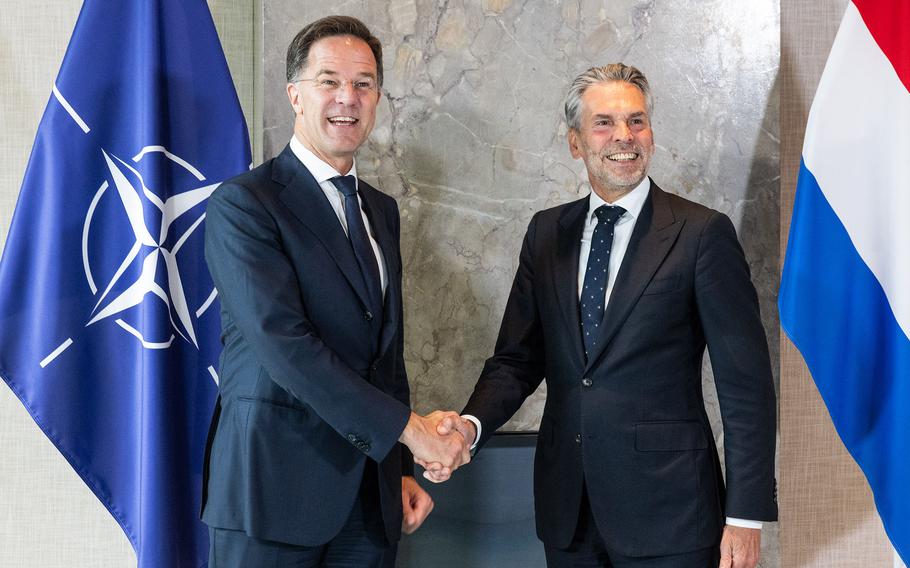
NATO Secretary General Mark Rutte, left, meets with Dutch Prime Minister Dick Schoof at The Hague, Netherlands, June 23, 2025. The meeting preceded a two-day NATO summit where leaders are expected to back U.S. President Donald Trump’s call for members to spend 5% of gross domestic product on defense. (NATO)
NATO leaders are poised to meet President Donald Trump’s demand for big increases in defense spending that will enable Europe to take on more responsibility for its defense, the bloc’s top official said Monday.
During the two-day summit in the Dutch city of The Hague that kicks off Tuesday, allies will agree to dedicate 5% of their gross domestic product to defense, NATO Secretary General Mark Rutte said during a news conference in Brussels.
“This is a quantum leap that is ambitious, historic and fundamental to securing our future,” Rutte said.
Trump’s push for allies to dedicate 5% of GDP, up from the current 2% benchmark, is expected to deliver a jolt for nations that have faced heavy criticism from Washington over the years for lackluster military spending.
In the run up to the summit, Trump administration officials have insisted that members provide clear timelines for hitting the 5% benchmark.
In recent days, there have been questions about whether all 32 allies are on board with the plan. Spain, for example, has said it will be unable to hit the 5% mark.
Still, Rutte’s assertion that allies have reached a consensus indicates that there are unlikely to be any last-minute vetoes of the initiative, which requires unanimous agreement among NATO leaders.
The push for stronger militaries in Europe comes as the U.S. aims to shift more of the Pentagon’s focus to countering China.
Some analysts say most European leaders have gotten the Trump administration’s message on the need for more spending.
“This recognition will only strengthen NATO and should have occurred long ago,” wrote James Goldgeier, an expert on U.S.-European relations at the Brookings Institution, ahead of the NATO summit.
Another aim for Europe coming out of The Hague summit would be assurances that if the U.S. reduces troop levels on the Continent, it will be “an orderly transition process of shifting the burden rather than a sudden, uncoordinated U.S. retreat,” Goldgeier said.
Rutte did not detail how the new NATO spending benchmark would be enforced or what the timeline would be for hitting the mark.
The 2% benchmark was agreed upon in 2014, with an implementation date of no later than 2024. Last year, 23 allies met the mark. All 32 members will reach the target this year, Rutte said.
In 2029, allies will assess progress toward the 5% benchmark, said Rutte, who left open the possibility that allies might need to raise levels even further.
With increased spending, allies also have pledged to hit new capability targets that will add a fivefold increase in air defense capabilities, Rutte said.
“By investing more and producing more, we build a stronger NATO,” Rutte said.
More details on the plan are expected when heads of state meet Wednesday.
The NATO plan will call for members to spend 3.5% on traditional military capabilities, such as tanks and air defense equipment, and 1.5% would be dedicated to unspecified military infrastructure.
How infrastructure gets defined will be a key factor in determining whether the NATO agreement will deliver sufficient hard power, some analysts contend.
The only viable way for some allies to reach 5% of GDP on defense spending is to redefine what counts, said John Deni and Ryan Arick, two NATO experts with the Atlantic Council.
“Although this rhetorical sleight of hand may enable allies to reach the magic number, it also carries significant risk insofar as allies may seek to count any number of questionable budgetary expenditures as ‘defense-related,’ ” Deni and Arick wrote Friday in an analysis of the upcoming summit.
For example, sufficient roads, ports and rail networks are needed for the movement of troops and gear. But without clear guidelines, allies could claim virtually any type of public works project to be for defense purposes.
“Russian tanks can’t be defeated by allied rail cars,” Deni and Arick wrote. “At the same time, NATO tanks are only as useful as their ability to get to a potential front … the Alliance should establish a process or mechanism to clearly identify standards and priorities for defense-related expenditures.”